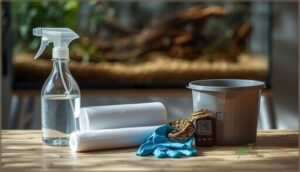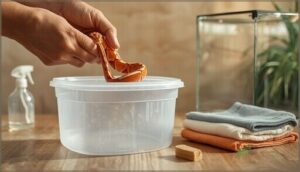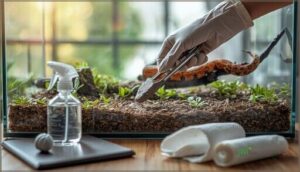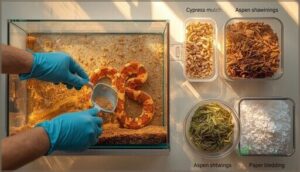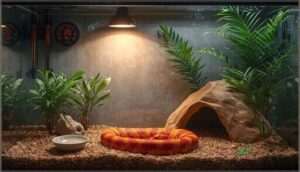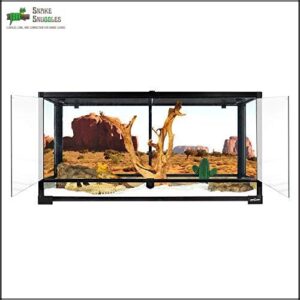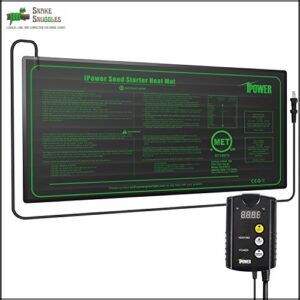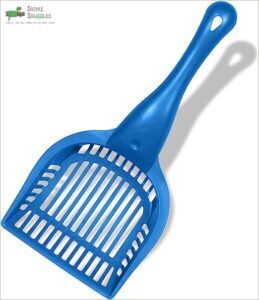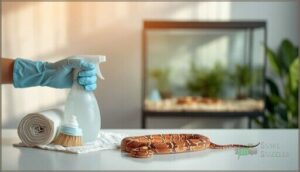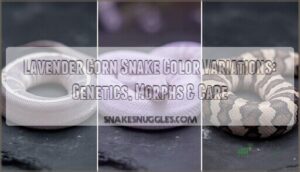This site is supported by our readers. We may earn a commission, at no cost to you, if you purchase through links.
A corn snake cage that smells musty or looks grimy isn’t just unpleasant—it’s a health hazard that can lead to respiratory infections, scale rot, and parasitic infestations. Your snake depends entirely on you to maintain a clean environment, since it can’t escape harmful bacteria or ammonia buildup the way a wild snake would.
Regular cleaning prevents these problems, but many snake owners struggle with knowing exactly what to do. Spot cleaning should happen daily to remove feces and urates, while deep cleaning requires disinfecting every surface monthly.
The right approach protects your snake’s health without causing unnecessary stress during the process. Mastering how to clean a corn snake cage means understanding when to act, which products are safe, and how to reassemble the habitat so your snake stays comfortable and disease-free.
Table Of Contents
- Key Takeaways
- How Often to Clean a Corn Snake Cage
- Tools and Supplies for Safe Cleaning
- Preparing Your Corn Snake and Enclosure
- Step-by-Step Spot Cleaning Instructions
- Monthly Deep Cleaning Procedure
- Cleaning and Changing Substrate Safely
- Maintaining Temperature and Humidity After Cleaning
- Top 5 Products for Cleaning Corn Snake Cages
- Health and Safety Tips During Cleaning
- Troubleshooting Common Cleaning Problems
- Frequently Asked Questions (FAQs)
- Conclusion
Key Takeaways
- Daily spot cleaning removes waste and prevents ammonia buildup, while monthly deep disinfection with reptile-safe cleaners eliminates harmful bacteria that cause respiratory infections and scale rot.
- Strong odors, visible feces, or ammonia levels signal immediate cleaning is needed—waiting even a day or two increases your snake’s risk of respiratory problems and dangerous bacterial growth.
- Use 70% isopropyl alcohol or chlorhexidine-based disinfectants on all surfaces, rinse thoroughly with deionized water, and allow complete air drying before returning your snake to prevent chemical exposure.
- Replace substrate every 1–2 weeks when you notice darkening from moisture, persistent odors despite cleaning, mold growth, or waste caking—these signs indicate bacterial overload that threatens your snake’s health.
How Often to Clean a Corn Snake Cage
Staying on top of your corn snake’s cleaning routine isn’t just about looks—it’s about keeping them healthy and stress-free. There’s more to it than simply changing the bedding now and then.
Here’s what to know about how often you should clean, broken down by the different ways you’ll care for their space.
Spot Cleaning Vs. Deep Cleaning
When you think about cleaning efficacy and your corn snake’s well-being, it’s helpful to picture daily spot-cleaning as your front line—quick sweeps for waste and uneaten food keep odor under control and reduce snake stress.
Deep cleaning, on the other hand, is a monthly ritual. That’s where the real time investment pays off in thorough pathogen removal and healthier conditions.
Addressing these issues can be similar to tackling community and social issues by maintaining a healthy environment.
Recommended Cleaning Schedule
Building consistency into your cleaning routine helps keep your corn snake healthy and your maintenance manageable. Aim for daily spot-cleaning and a deep-clean every month, but make seasonal adjustments for changes in humidity, your snake’s age, enclosure size, and activity level.
Younger snakes or larger enclosures may need a more frequent cleaning schedule to keep everything fresh and safe. This can be achieved through thorough reference checking to confirm no areas are missed.
Recognizing When Immediate Cleaning is Needed
It doesn’t take long for odor intensity or foul odors to signal when your corn snake’s cage needs urgent attention. Visible fecal matter, high ammonia levels, and rapid waste buildup during shedding season mean it’s time for immediate cleaning—waiting even a day or two raises the risk of respiratory issues and lets pathogens and bacterial buildup get out of hand.
Strong odors, visible waste, or ammonia buildup signal your corn snake’s cage needs immediate cleaning to prevent respiratory issues and dangerous bacterial growth
Tools and Supplies for Safe Cleaning
Before you start cleaning your corn snake’s cage, it helps to know what gear you’ll need. Getting the right tools makes the whole process easier and safer for both you and your snake. Here’s what you’ll want to have on hand.
Essential Equipment Checklist
Every corn snake enclosure clean starts with the right gear: a reptile-safe disinfectant (with proven Disinfectant Efficacy), a soft brush (look for quality Brush Material), gloves for Glove Hygiene, and a substrate siphon.
Add a water testing kit, microfiber towels, and a sturdy paper towel roll.
Each item protects both you and your snake from exposure and cross-contamination.
Choosing Reptile-Safe Cleaners
For your corn snake’s safety, choosing the right cleaner means focusing on natural disinfectant efficacy, safe ingredient labels, and veterinary recommendations. Chemical residue risks are real—most experienced keepers avoid household bleach, leaning into trusted reptile-safe solutions instead. Long-term impacts matter, so opt for:
- pet-safe vinegar-based formulas
- third-party certified reptile disinfectants
- eco-friendly plant-based options
Proper Use of Gloves and Brushes
During enclosure cleaning, gloves aren’t just another accessory—they’re your first barrier. Choose nitrile for trusted Glove Material, shielding you from safe disinfectants and cutting dermal absorption risk.
Brush Stiffness around 2–3 helps clear waste without scraping substrates. Routine Cleaning Frequency—weekly or as needed—means less Surface Contamination.
Safe handling during cleaning protects both you and your snake every time.
Preparing Your Corn Snake and Enclosure
Before cleaning, you’ll need a safe place to put your corn snake. Helping your snake stay calm and secure will make the whole process easier for both of you.
Here are a few good options you can use while you freshen up their main home.
Safe Removal and Temporary Housing
Did you know that keeping housing temperature stable and offering water availability even during cleaning can greatly aid stress reduction in your corn snake? Snakes sense change quickly, so minimizing stress response during temporary housing leads to easier transitions and safer handling during cleaning.
Use transport methods like a travel tub or small terrarium for safe removal—this gives you both a breather. Safe handling techniques matter, too: limit handling duration and pick gentle, secure transfer.
Minimizing Stress During Handling
It’s easy to underestimate just how much a routine cage cleaning can rattle your snake’s nerves. A little planning goes a long way for stress reduction in snakes: gentle handling and gradual acclimation help your corn snake adjust. Watch closely for stress indicators—like quick tongue flicks or flattening—while using safe handling techniques.
To keep your snake’s stress response low during enclosure interaction, remember:
- Maintain handling frequency at two to four short sessions weekly.
- Move with calm, intentional movements.
- Always provide a stable shelter post-handling.
Step-by-Step Spot Cleaning Instructions
Spot cleaning keeps your corn snake’s home fresh and healthy day to day. Here’s what you’ll need to handle and how often to do it.
Let’s break things down step by step so nothing gets missed.
Removing Waste and Soiled Substrate
Ever noticed how persistent odors often hint at hidden waste? Keeping your snake’s habitat clean means regular waste removal—especially feces and urates. Aim for spot cleaning weekly and replace soiled substrate before moisture builds.
This lowers microbial load, keeps pH balance in check, and helps with odor control. Proper waste disposal also protects respiratory health and prevents substrate issues.
Cleaning and Refilling Water Bowls
Think of water bowls as the lifeline for your corn snake’s hydration and hygiene. Washing and refilling every day helps keep bacterial growth in check and ensures the sanitation needed for reptile health.
Use safe cleaners and rinse thoroughly, especially if using metal or glass. Keeping water at room temperature maintains balance, and a quick daily check prevents dehydration signs before they start.
When to Replace Absorbent Liners
Keeping water bowls safe leads right into smart liner care. You’ll want to swap out absorbent liners after spot-cleaning any waste, and always when you find:
- Liner saturation or damp bedding
- Noticeable odor control issues
- Mold prevention is needed (visible spots)
- High waste output from your snake
- Persistent humidity levels above 60%
Regular checks prevent overlooked problems.
Monthly Deep Cleaning Procedure
A thorough clean keeps your corn snake healthy and lowers the risk of hidden bacteria. Monthly deep cleaning reaches beyond daily spot checks, hitting every corner your snake calls home. Here’s what to do step by step.
Disassembling and Removing Decor
During monthly cleaning, disassembling decor boosts cleaning efficiency and reduces contamination. Safe handling during and after cleaning means gloves and soft tools prevent cross-contamination and wear. Documenting decor layout with a photo or sketch before removal makes reassembly safe and stress-free.
This routine helps maintain your snake’s enclosure, supporting the right cleaning frequency and overall habitat health.
Disinfecting All Surfaces and Accessories
Now comes the real core of cleaning and disinfecting: every surface and accessory deserves careful attention. Alcohol efficacy stands out—70% isopropyl knocks out microbes within minutes. A bleach solution or enzyme cleaners work wonders on tricky grime, but always check material compatibility. Remember, safe disinfectants need full contact time. Here’s a quick guide:
- Alcohol efficacy
- Chlorine usage
- Enzyme cleaners
- Contact time
- Material compatibility
Thorough Rinsing and Drying
After thorough cleaning and disinfection, rinsing everything with deionized water cuts substrate dust by 52%. Once rinsed, air drying keeps humidity in check, limits fungal sporulation risk, and curbs odor. Use a lint-free towel for a quick wipe—this shrinks odor re-emergence over the next week.
Here’s a handy summary:
| Step | How It Helps | Timing |
|---|---|---|
| Rinse with DI water | Substrate Dust Removal | Immediate |
| Air Dry | Humidity Control | 1–2 hours |
| Lint-Free Toweling | Odor Re-emergence | After drying |
| Inspect Surfaces | Fungal Sporulation Risk | Before reset |
| Replace Accessories | Mineral Deposit Prevention | After wipe |
Cleaning and Changing Substrate Safely
Choosing the right substrate keeps your corn snake comfortable and healthy. There are several options, each with their own advantages.
Here’s what you need to know before making your pick.
Types of Substrate and Their Benefits
Ever wondered why substrate choice matters so much? Your corn snake’s comfort hinges on more than softness. Substrate porosity impacts humidity control, while odor control is influenced by bedding and waste management. Aspen shavings, cypress mulch, and bioactive enclosure setups each offer unique benefits for humidity interactions, safety, and toxicity considerations.
- Aspen bedding: low odor, but monitor for contamination
- Cypress mulch: holds moisture, less burrowing into waste
- Coconut fiber: balances humidity, compostable
- Bioactive setups: natural odor reduction, lower maintenance
How to Dispose of Used Substrate
When disposing of used substrate, safe handling and regulatory compliance go hand-in-hand with good reptile care. Always bag bedding securely for waste removal, especially when fecal material is present.
Check if composting suitability or waste reduction programs exist locally. Responsible disposal reduces environmental impact—never dump substrate outdoors, and follow guidelines to avoid contaminating soil or water during bedding replacement.
Signs The Substrate Needs Changing
When you notice substrate moisture darkening the bedding, persistent foul odors despite odor control, or even mold growth clinging to decor, it’s time for a change.
Substrate depth shrinking below the recommended level signals lost absorbency, increasing the risk of bacterial buildup.
Waste, fecal material, or caking after handling all point to a substrate overrun by pathogens.
Maintaining Temperature and Humidity After Cleaning
Getting the right balance of temperature and humidity after cleaning is key for your corn snake’s well-being.
Every enclosure type makes maintaining these conditions a little different. Here’s what you should know before choosing your setup.
Resetting and Monitoring Environmental Controls
A well-calibrated sensor is your best friend for tracking temperature and humidity control after cleaning. Place sensors at both the warm and cool ends, making temperature gradients clear—a must for thermoregulation. Humidity calibration with a quality hygrometer keeps shedding and respiratory health on track.
Remember, daily air exchange safeguards against stuffy enclosures, while steady routines reduce your corn snake’s stress. Monitor environmental conditions closely; even small changes in sensor placement can make a real difference in stress reduction.
Restoring Proper Heating and Lighting
Think of your snake’s cage like a weather system: small shifts in heat and light have big impacts. After cleaning, double-check Basking Spot Temps using a thermometer and confirm thermostat accuracy—most digital models can drift by a couple of degrees.
Restore your photoperiod: aim for 12–14 hours of light with a reliable basking lamp.
Redundant controls, like a backup thermostat or dual thermometers, help stabilize your temperature gradient and manage the influence of humidity changes—keeping your corn snake healthy.
Top 5 Products for Cleaning Corn Snake Cages
Having the right cleaning tools makes a big difference for both you and your corn snake. If you’re not sure where to start, these five products have earned their place in many reptile keepers’ routines.
Here’s what you need to know to keep your snake’s home fresh and healthy.
1. REPTI ZOO 50 Gallon Terrarium Tank
Ever wished cleaning your corn snake’s habitat felt less like a juggling act? The REPTI ZOO 50 Gallon Terrarium Tank makes routine enclosure care easier. Its Double Hinge Door design streamlines daily access, and the Screen Ventilation keeps airflow steady, helping you maintain ideal temperatures. The Waterproof Bottom withstands spills or humidity spikes without fuss.
If you enjoy customizing, this tank gives you options, though you’ll want to take care during assembly—it needs leveling and a light hand with heavy fixtures.
Best For: Beginner and intermediate reptile keepers who want a customizable, easy-access tank for corn snakes or similar pets.
- Double hinge doors allow hassle-free spot cleaning and maintenance.
- Screen ventilation keeps air fresh and supports healthy humidity and temperature levels.
- Raised, waterproof bottom works for both desert and rainforest setups.
- Can feel unstable if not carefully leveled or assembled.
- Screen sides make high humidity difficult to maintain.
- Instructions may only be available in English, which could be limiting.
2. ReptiChip Coconut Reptile Substrate Bedding
If you’re looking for bedding that checks most boxes for your corn snake, ReptiChip Coconut Reptile Substrate stands out. This eco-friendly, 100% organic option locks in just enough humidity for healthy sheds and keeps odors at bay longer than many loose shavings.
Its structure reduces dust, too—a relief for both your snake’s breathing and your cleaning routine.
While chunky texture means it isn’t the top pick for deep burrowing, it offers easy spot cleaning and reliable odor control for weeks.
Best For: Keepers who want odor control, stable humidity, and a low-mess routine for their corn snakes—without the hassle of endless spot cleaning.
- Absorbs odors and holds humidity well for healthy shedding.
- Cuts down on dust, making cleaning and breathing safer.
- Eco-friendly and easy to maintain with simple spot cleaning.
- Chunky texture isn’t ideal for snakes that love to burrow deeply.
- Can get dusty or moldy if overwatered during setup.
- Costs more than many traditional reptile bedding options.
3. iPower Seedling Heat Mat Combo
For many keepers, a steady temperature in the enclosure isn’t just a luxury—it’s a must for both cleaning success and your corn snake’s comfort. The iPower Seedling Heat Mat Combo offers reliable temperature regulation with its digital thermostat, keeping your setup within the needed range during maintenance.
Uniform warmth means substrate dries evenly and humidity resets quickly after cleaning. Originally designed for seedling germination, this heat mat boasts sturdy safety features and waterproofing, making it a flexible, affordable solution—well-suited even for alternative uses around your home.
Best For: Keepers who need precise, reliable temperature control for their snake setups—especially during frequent cleaning and humidity adjustments.
- Digital thermostat keeps heat steady, so your snake’s environment stays safe during and after cleaning.
- Waterproof and easy to wipe down, so it can handle messes and humid conditions without a fuss.
- Doubles as a multi-use heat source, handy for both enclosures and starting spring seedlings.
- Needs proper placement—immersing the thermostat or putting the sensor in water can cause errors or inaccurate readings.
- Maximum wattage and amps mean you can’t plug in too many devices at once.
- Error codes like “E1”, “E2”, and “E3” require you to troubleshoot if the environment gets too cold, too hot, or if the sensor malfunctions.
4. Pureness Regular Durable Litter Scoop
For cleaning a corn snake enclosure, a reliable litter scoop makes short work of Pet Waste Management. The Pureness Regular Durable Litter Scoop stands out for its sturdy, high-impact plastic and slotted Litter Scoop Design—great for snake waste removal techniques and quick spot cleaning.
Its odor-resistant Cleaning Tool Materials fit well into your Odor Control Methods. Practicing Sanitation Best Practices means using the right tool: this scoop’s easy-to-clean build aids in a safe, efficient routine for your snake enclosure cleaning frequency.
Best For: Reptile and snake owners who want a durable, easy-to-clean scoop for fast, odor-resistant daily spot-cleaning of medium to large enclosures.
- High-impact plastic and polished finish resist stains and odors, making cleanup quick.
- Slotted design makes it easy to sift through and remove waste from various substrates.
- Lightweight and comfortable for spot-cleaning roles in regular maintenance routines.
- Handle may bend or snap if used with excessive pressure or heavy materials.
- Slots can let smaller debris pass through, requiring a second pass for fine cleanup.
- Not ideal for non-clumping or very dense, heavy substrates.
5. Exo Terra Reptile Mister Spray Bottle
After scooping waste, maintaining proper humidity is your next order of business. The Exo Terra Reptile Mister Spray Bottle is a mainstay for Mister Maintenance and humidity control. Its adjustable nozzle lets you fine-tune misting techniques, whether you’re rehydrating substrate or supporting reptile hydration after cleaning.
Spray Bottle Safety matters, so always use distilled water and store the device upright. Designed for reliability, this tool fits well into gentle reptile care and helps you keep your snake enclosure safe for weeks to come.
Best For: Reptile keepers and plant enthusiasts who need reliable, adjustable misting for maintaining humidity in terrariums or greenhouses.
- Large 67.5 fl oz reservoir means less frequent refilling for big enclosures.
- Adjustable spray nozzle allows fine-tuning for different misting needs.
- Locking mechanism makes continuous spraying easy and less tiring.
- Some users report leaks from the nozzle or top seal.
- Requires frequent pumping to maintain pressure during long use.
- Handle may feel thin and less durable over time.
Health and Safety Tips During Cleaning
Before you grab your cleaning tools, a few key safety habits make all the difference. Keeping yourself and your snake healthy is just as important as a clean enclosure.
Here’s what you should keep in mind during every cleaning.
Handwashing and Hygiene Protocols
Ever wondered how much a simple wash can shield both you and your corn snake? Washing hands with soap for at least 20 seconds beats quick rinsing, slashing bacterial buildup and zoonotic risks.
Save alcohol sanitizers for spotless surfaces; always swap gloves between tasks. Using the right glove protocol and safe disinfectants is at the heart of health and hygiene tips for preventing bacterial growth.
Reducing Snake Stress
A peaceful enclosure starts with mindful steps. Gentle handling during cleaning keeps your snake’s stress response low. Choosing the right substrate and keeping the layout familiar build confidence. Stable temperatures matter—thermal stability helps snakes relax. Lower noise during cleaning, too; it goes a long way. Each thoughtful move makes safe handling routine and reduces stress in your corn snake.
- Gentle Handling every session
- Choose low-dust substrate for calm
- Keep temperatures steady (thermal stability)
- Clean quietly to prevent agitation
- Maintain layout consistency in the enclosure
Early Signs of Health Issues
Observation is your strongest safeguard for reptile health. Appetite changes or lethargic behavior often signal snake health concerns. Watch for abnormal shedding, scale abnormalities, or respiratory distress like wheezing—these may follow lapses in hygiene. Recognizing poor hygiene signs early means you can act before animal health deteriorates.
| Sign | What You Notice | What It May Mean |
|---|---|---|
| Appetite Changes | Won’t eat as usual | Stress, illness, infection |
| Scale Abnormalities | Discoloration, sores | Poor hygiene, scale rot |
| Respiratory Distress | Wheezing, open mouth | Infection, high humidity |
| Lethargic Behavior | Less movement | Sickness, overheating |
| Abnormal Shedding | Retained skin patches | Low humidity, health issues |
Troubleshooting Common Cleaning Problems
Even a well-kept corn snake cage can run into a few stubborn problems now and then. Odors, bacteria, and surprise health issues sometimes show up despite your best efforts.
Here’s what you might face—and how you can tackle each one.
Persistent Odors and How to Fix Them
If enclosure odor lingers despite waste removal, you’re likely dealing with ammonia buildup or substrate fermentation. Spot-clean twice weekly and replace substrate every 2–4 weeks to cut odor by 40–60%.
Check water bowls for biofilm formation—scrub them during each cleaning.
Improve ventilation and keep humidity below 60% to support odor containment. These steps help you maintain a fresher habitat between deep cleans.
Preventing Bacterial Growth
Routine waste removal cuts bacterial load by 60% within 24 hours, so daily spot-cleaning is your first defense. Pair it with the right substrate choice—coconut husk or reptile carpet—and weekly water hygiene to reduce exposure by 70%.
- Surface disinfection: Use reptile-safe cleaners for 99% bacterial reduction in five minutes.
- Thermal stability: Maintain consistent heat and humidity to lower infection risk by 15–20%.
- Substrate changes: Replace bedding every 1–2 weeks to cut bacteria by 25–40%.
- Cleaning and disinfecting: Combine routine reptile habitat maintenance with thorough sanitation for best results.
When to Consult a Reptile Veterinarian
Even diligent cleaning can’t solve every problem. If your corn snake shows respiratory distress, refuses food for more than two weeks, or displays abnormal shedding after maintenance, seek veterinary care immediately.
These signs point to underlying disease that requires professional infection management. Prompt veterinary consultation protects animal health and welfare—don’t wait for snake emergencies to worsen.
Frequently Asked Questions (FAQs)
Can I use bleach to clean snake cages?
While it’s tempting to reach for bleach, it’s a bit like using a sledgehammer to crack a nut. You can use a 10% bleach solution for non-porous surfaces, but thorough rinsing is critical, fume hazards are real, and porous surfaces risk material damage.
Reptile-safe solutions—like chlorhexidine or F10SC—offer safer alternatives explored by many keepers for deep cleaning instructions without the toxin worries. Safe rinsing and proper ventilation protect your snake during enclosure sanitation.
How do you clean fake plants safely?
You can clean fake plants by soaking them in diluted reptile-safe disinfectant like Zilla Terrarium Cleaner, scrubbing gently to avoid material damage, then rinsing thoroughly to remove residue before returning the décor to your terrarium.
What temperature should disinfectant water be?
You should prepare disinfectant solutions at room temperature—about 20–25°C (68–77°F). This range promotes reptile safety, maintains disinfectant efficacy, and follows product guidelines for proper reptile care without stressing your snake.
Should I clean the cage with snake inside?
Most reptile care experts advise against it. Safe removal of corn snakes before cleaning reduces enclosure stress and exposure to fumes. Temporary housing during cleaning protects reptile welfare and minimizes handling precautions.
How long until snake can return after cleaning?
After spot cleaning, wait 24 to 48 hours before returning your snake, allowing proper ventilation time and disinfectant safety. Full substrate replacement requires 72 hours for temperature stability and stress reduction in snakes.
Conclusion
Learning how to clean a corn snake cage is like mastering a routine that protects your pet’s future. Daily spot cleaning prevents waste buildup, while monthly deep disinfection eliminates hidden bacteria.
Your snake can’t ask for a healthier space, but it’ll show you through clear eyes, smooth sheds, and active behavior. Consistency matters more than faultlessness. Stay observant, use safe products, and never skip the basics—your corn snake depends on that commitment every single day.
- https://www.stitcher.com/podcast/herp-nation-radio/e/51162653?autoplay=true
- https://www.facebook.com/ZillaRules/
- https://www.5staressays.com/blog/research-paper-guide
- http://law.gtu.ge/wp-content/uploads/2017/02/Berg-B.-Lune-H.-2012.-Qualitative-Research-Methods-for-the-Social-Sciences.pdf
- https://michaelbjorkwrites.com/2019/09/26/story-themes-list-ideas-for-your-novel/


